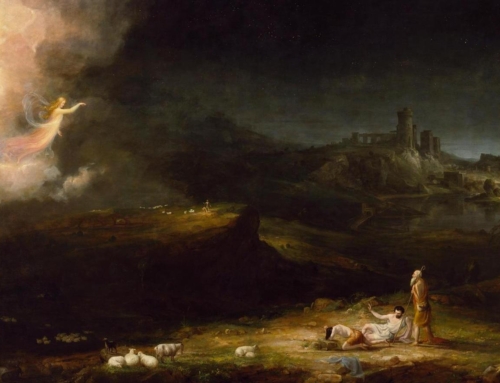And he said to them, “Oh, how foolish you are! How slow of heart to believe all that the prophets spoke! Was it not necessary that the Messiah should suffer these things and enter into his glory?” Then beginning with Moses and all the prophets, he interpreted to them what referred to him in all the scriptures.
—Luke 24:25-27
In the previous two posts, we stated that prophetic speech in the Bible
1. needs to be interpreted;
2. reveals its message to some people while concealing it from others;
3. and has multiple layers of true interpretation and multiple true fulfillments.
Now that we’ve had a look at the first two, let us see how Scripture interprets Scripture as a means of understanding the third and perhaps least obvious one.
In the light of the Holy Spirit, history is never just a collection of brute facts. All of history, down to the fall of a sparrow, is ruled by the almighty providence of a God who is eternal and all-knowing, in a way that doesn’t negate the free will of the people he created and sustains in being. Because of God’s providence, history itself is more richly layered with meaning than the most splendid novel ever written. Much of Sacred Scripture, then, is the theological interpretation of the past, putting it in the context of the present, the future, and God’s eternity.
Because of this, the whole of Scripture, even records of historical events, can be interpreted as a kind of prophecy. This is in fact how Jesus interprets the entire Old Testament—as prophecy about him. We can read from Genesis to Deuteronomy very closely and not find a single verse that says plainly that “the Second Person of the Holy Trinity will unite human nature to Himself in hypostatic union and be born of a virgin named ‘Mary’ in Bethlehem during the reign of a future king you’ve never heard of. Be sure not to misjudge him, because he is the Messiah—even though he might get you pretty annoyed, like all the prophets will.” Yet Jesus insists that Moses, meaning the books of the Pentateuch, tells of him. Clearly if Jesus is right, and we know in faith that he is, prophetic interpretation of the sort we have been learning is required in order to understand what he means.
Jesus and his contemporaries—even his enemies—agreed that past events recorded in Scripture could be interpreted as multi-layered prophecy. To illustrate, see Matthew 2:4-6. When the Magi asked Herod where to find “the newborn king of the Jews,” Herod assembled “all the chief priests and the scribes of the people” and “inquired of them where the Messiah was to be born.” They told him “in Bethlehem of Judea” and cited Micah 5:1 as evidence. But if you look at the passage from Micah yourself, you will see that its original historical context has to do with military and political deliverance from the threat of the Assyrians hundreds of years before Christ. Which meaning is the “right” one? Both of them.
But a prophetic vision or oracle can have more than just two meanings, one immediate and historical, the other about Jesus. Jesus’ own interpretation of part of the Book of Daniel shows us how one prophetic sign can have multiple fulfillments throughout history.
In Daniel 8, Daniel has a prophetic vision that is difficult for him to understand. He prays, and the angel Gabriel comes twice to explain the vision to him, once in chapter eight and once in chapter nine. The angel interprets part of the vision as referring to what he calls the “desolating abomination” (Dn 9:27).
When interpreting the Book of Daniel, Jesus refers to “the desolating abomination spoken of through Daniel the prophet” as something that has yet to come (Mt 24:15, Mk 13:14); but at the same time, the angel Gabriel in Daniel 8 states clearly that Daniel’s vision and all it contains refer to the actions of the Medes, Persians, and Greeks (Dn 8:20), actions that happened well before Jesus’ lifetime.
So on Jesus’ authority, the “desolating abomination spoken of through Daniel the prophet” has at least two fulfillments in the course of history.
Our understanding of the kind of prophecy the Book of Revelation is will be enriched if we take note of the type of writing in the Bible called “apocalyptic.” “Apocalypse” (Greek ἀποκάλυψις, “apocalypsis” in the Latin of the Vulgate) is the self-designation of the Book of Revelation in verse 1, though in English we often call it “revelation.” Both words contain the idea of the drawing back of a veil. A form of this word is used in the Book of Daniel (Dn 2:22 and 2:28) to describe what Daniel does, or rather what God does through Daniel.
If you are not familiar with the genre of apocalyptic literature, an excellent way to learn about it is to study the Book of Daniel closely. There are many books of this style produced by ordinary human authorship without divine inspiration, but Daniel is the Old Testament’s outstanding example.
The more familiar you become with the characteristics of the Book of Daniel, the more you will notice that there are other books in the Bible that have apocalyptic qualities or passages, such as Ezekiel, Isaiah, and Zechariah.
In apocalyptic literature, hidden meaning abounds, concealed behind strange imagery. There is often a heavenly messenger who mediates and sometimes explains the message. The book may be rooted in historical events, but the future looms into view, and the discourse is directed toward the consummation of history in the “day of the Lord.”
Although it may be useful to distinguish literarily between “prophets” and “apocalypse” as the NABRE does, clearly the two are not mutually exclusive—Revelation calls itself both “apocalypse” and “prophetic message,” and many Old Testament prophets have apocalyptic elements. Both will help us understand the Book of Revelation, but the Old Testament books where they overlap will be especially useful.
In Matthew 24, Jesus gives his interpretation in the context of an apocalyptic discourse that itself has multiple referents. Historical scholars will tell you, quite correctly, that the immediate historical referent of Jesus’ speech is the impending destruction of Jerusalem. Since this involves the destruction of the Temple, considered by Jews to be the most important thing in the world and a ‘microcosm’ of the universe, this is rightly considered an ‘end of the world.’ But it is not difficult for a reader reading with the eyes of faith to perceive that this apocalyptic discourse of Jesus is applicable to the end of the world properly speaking as well.
Jesus’ apocalyptic prophecy interpreting Daniel’s apocalyptic prophecy creates a text remarkably dense and rich in meanings, layer upon layer upon layer, none of which can be opposed to the others. All of these meanings are present at once in the original vision of Daniel, but can only be understood through the steady unfolding of divine revelation, received and responded to in faith.
Having seen all this, we will not be confused by the manifold interpretations the prophetic visions of the Book of Revelation demand. When we figure out one interpretation, we will not stop there, but will expect that there are others as well, some of which have been fulfilled in the past, and some of which remain for future ages.
Now that we have looked at the three principles of Biblical prophecy, our first round of preparation to read the Book of Revelation is complete. Going forward, we will arm ourselves further for a profitable reading of the Book by studying some Old Testament prophecies that it quotes or alludes to directly. Remember that whatever language one reads the Book of Revelation in, the “language” of its symbols is, by and large, “Old Testament.” Therefore, building up our Old Testament “vocabulary” will increase our comprehension of the prophetic visions of St. John’s Apocalypse.
Image: Willem Drost, The Vision of Daniel







